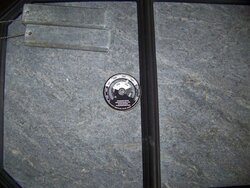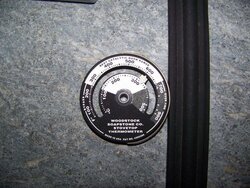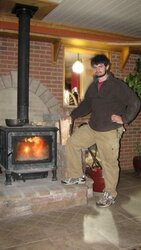Sorry if I offended anyone. I never intended to imply that soapstone was bad. I own I soapstone stove and I don't regret buying it at all. I love it. I will say it again my Hearthstone Mansfield is an excellent stove and it heats very well, much better than any fireplace. All I am saying is that steel and cast iron are more efficient when it comes to radiating heat. Let me explain my theory. I base this on scientific facts and my own controlled experiments. This year I am doing my senior project and it is on wood stoves. I am still in high school so you don't have to listen to me but I have done alot of research. I am designing a wood stove. I am designing it to release maximum amount of heat on a minimal amount of wood. Recently 2 stove dealers offered me a job to work as a salesman after having a conversation with them while I was searching for a stove for the Cabin I plan to move to. One of the stove dealers specialized in Hearthstone soapstones, I have a lot of good things to say about soapstone too.
I have experience burning in several stoves. I have personally burned in a Hearthstone Mansfield, Harman Oakwood, 5700 step top Quadrafire, Mama Bear Fisher stove, and various others. My experiment involved the Harman Oakwood (Cast Iron) and a Hearthstone Mansfield (Soapstone) being rotated in my living room. (The flue was installed by a professional so there are no problems there we get great draft-not too much not too little and my father and I are basically professional movers of anything so we have no trouble moving the heavy stoves around). Although the Oakwood has a smaller firebox and surface area it out heated the Mansfield on the less wood. I used Hickory wood that had been seasoned for 14 months and I laid out 8 stove loads of similar sized splits for each stove. I burnt each stove for 2 days straight with similar weather conditions on temperatures (snowing and around 30 day 25 night). I have a record of the flue temperatures and stovetop temps. I used two stovetop Rutland burn indicators (not highly accurate)-one on the flue (8 inches above stove top) one on the stove corner (equivalent locations for each). The Oakwood stovetop temperatures were higher until the embers finished burning. The Mansfield’s surface remained warm for quite a few hours after, but warm to the touch- somewhere around 100 F, not really heating the room. The flue temperatures were on average 50 degrees within each other. The Oakwood generally had lower flue temps. While the Oakwood was installed I was maintaining 70 in my room. With the Mansfield my room held around 68.
So I concluded as far as heating efficiency goes steel or cast iron stoves perform better. I also concluded that both stoves performed great since I successfully heated 1585 sq ft of space to my likings in a ranch style house with both stoves. My stove location is far from optimal ( the northern extreme of my Ranch House that runs longways north to south), but I had no available central areas to install a flue in the house. It is very impressive that both stoves performed well enough to heat that much space even in the worst conditions.
I have experience burning in several stoves. I have personally burned in a Hearthstone Mansfield, Harman Oakwood, 5700 step top Quadrafire, Mama Bear Fisher stove, and various others. My experiment involved the Harman Oakwood (Cast Iron) and a Hearthstone Mansfield (Soapstone) being rotated in my living room. (The flue was installed by a professional so there are no problems there we get great draft-not too much not too little and my father and I are basically professional movers of anything so we have no trouble moving the heavy stoves around). Although the Oakwood has a smaller firebox and surface area it out heated the Mansfield on the less wood. I used Hickory wood that had been seasoned for 14 months and I laid out 8 stove loads of similar sized splits for each stove. I burnt each stove for 2 days straight with similar weather conditions on temperatures (snowing and around 30 day 25 night). I have a record of the flue temperatures and stovetop temps. I used two stovetop Rutland burn indicators (not highly accurate)-one on the flue (8 inches above stove top) one on the stove corner (equivalent locations for each). The Oakwood stovetop temperatures were higher until the embers finished burning. The Mansfield’s surface remained warm for quite a few hours after, but warm to the touch- somewhere around 100 F, not really heating the room. The flue temperatures were on average 50 degrees within each other. The Oakwood generally had lower flue temps. While the Oakwood was installed I was maintaining 70 in my room. With the Mansfield my room held around 68.
So I concluded as far as heating efficiency goes steel or cast iron stoves perform better. I also concluded that both stoves performed great since I successfully heated 1585 sq ft of space to my likings in a ranch style house with both stoves. My stove location is far from optimal ( the northern extreme of my Ranch House that runs longways north to south), but I had no available central areas to install a flue in the house. It is very impressive that both stoves performed well enough to heat that much space even in the worst conditions.





